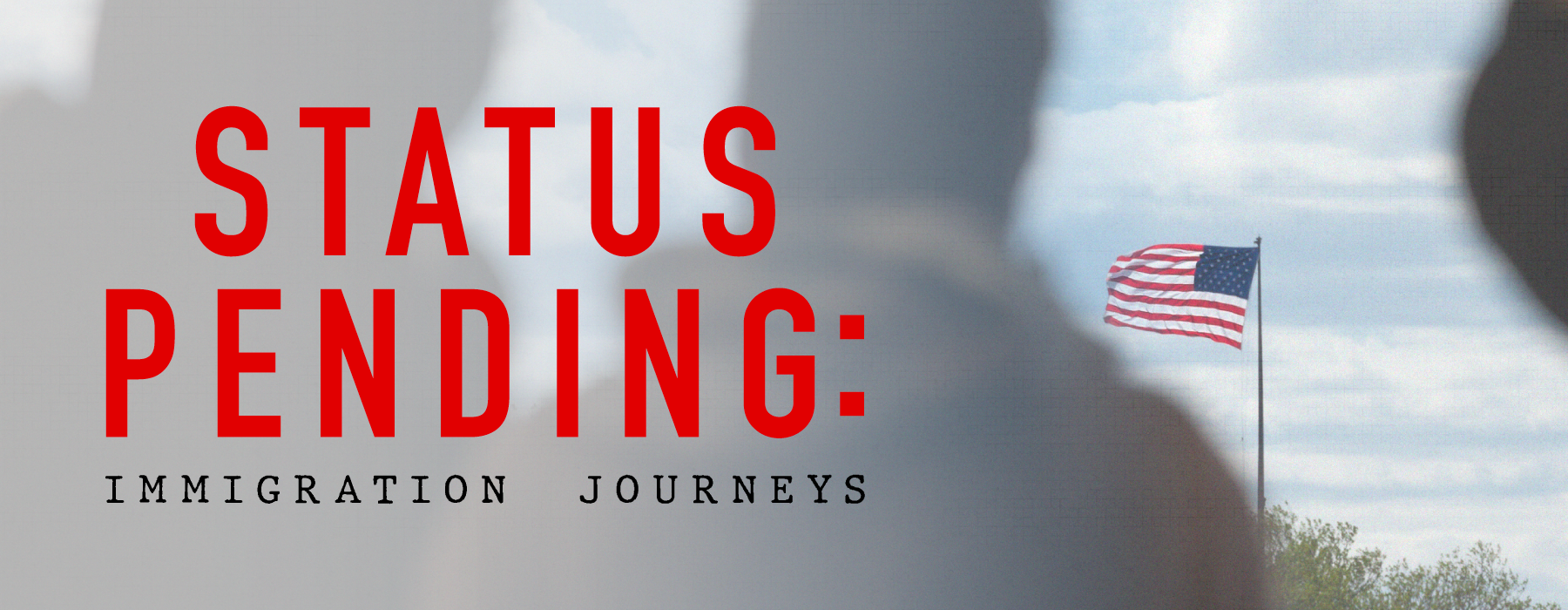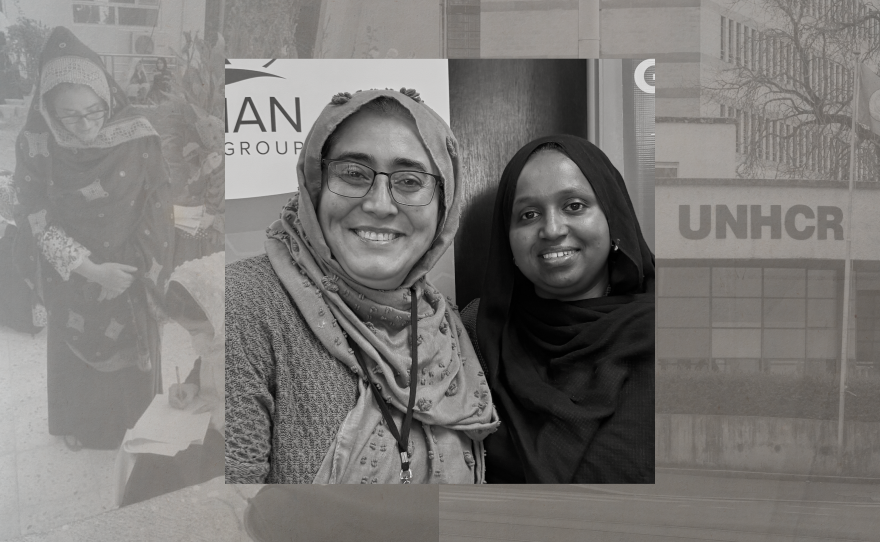Editor's note: After this story was published, the Trump administration further restricted U.S. refugee and asylum programs. United States Citizenship and Immigration Services (USCIS) announced it would stop processing visa applications for people from Afghanistan, and that it would halt all decisions on asylum applications. USCIS says it is reviewing security and vetting protocols after an Afghan national allegedly shot two National Guard members in Washington, D.C. President Trump promised to crack down on immigration from countries he described as "third world."
Original story:
Five years ago, Maryam Durani was enjoying all that she accomplished in Kandahar, Afghanistan.
She founded Kandahar Women’s Advocacy Network, which was led by women. She opened a women’s internet cafe, a library for women, a school, fitness center and the first women’s radio station in the south of the country.
But that work advocating for women's rights brought unwanted attention: death threats, attempted assassinations. She even had to go into hiding for six months.
Then, in 2021, the U.S. withdrew troops from the country and the Taliban took back power. That's when things got much scarier for Maryam.
“[The Taliban] start to tell me, they’ll kill me, kill [my] family and find [my] family,” she says. “And before the Kandahar government fell, a lot of my family members and friend were telling me, 'Maryam, you need to leave.'"
It was time to go, but getting out of Afghanistan seemed impossible.
First, she had to travel eight hours north to the capital city, Kabul. There, she and her family hid out for weeks waiting for the right time to rush to the airport, one of the few places still under U.S. guard. After almost getting caught a few times by the Taliban, they all made it to the airport. Soon they would be classified as refugees.
That year more than 2.7 million Afghans were displaced and qualified for refugee status.
And that’s what being a refugee meant: someone fleeing war or persecution, someone standing up for women’s rights — even at the cost of their own life. But when it comes to how the U.S. handles refugees, that all changed earlier this year.
One of President Trump’s first executive orders was suspending U.S. refugee admissions.
The business of resettling refugees
Uma Abdi is the refugee program director at Milwaukee’s Hanan Relief Group — one of the three resettlement agencies in the area. Earlier this year they were called Hanan Refugee Relief Group, but decided to rebrand considering Trump's orders.
“The moment that Trump stepped into office, [it was] the immediate suspension of the refugee resettlement program,” Uma says. “Along with that, the funding just went away immediately. And so as an agency that was like half $1 million overnight, just lost.”
On Trump's first day in office, he froze the refugee program and foreign aid. Two days later, 12,000 refugees were in a sort of limbo. Many were already cleared to enter the U.S but were locked out and stuck in holding countries. Two days after that, agencies like Hanan received "stop work" orders.
“We knew that we could not just close the doors and say we can no longer serve you,” says Uma. “Because when these refugees come into this country, the first person they see is someone from our agency that picks them up at the airport. And so they form that connection where you're literally their lifeline. You're the person that they come to for everything.”
Resettlement agencies, like Hanan, are taxpayer-funded. The government sets a budget: around $2,400 per refugee. Agencies use this money to help refugees with things like housing, food, clothes, basically starting a life. The catch is, this all happens in the first 90 days.
But before any of this happens, before the 90 days, or traveling to a new country, they need approval.
“These are individuals that are fleeing war, persecution, whether it's religious persecution or sexual orientation or violence,” Uma says. “And so they have to register themselves under UNHCR to become a refugee.”
UNHCR is the United Nations High Commissioner for Refugees. It's basically the doorway for people seeking refugee status. It approved people like Maryam and so many other Afghans’ refugee status. Some Afghans from the time were also granted TPS, Temporary Protected Status.
UNHCR also vets refugees — the most thorough vetting process of all immigrants entering this country.
“When they mention that they come from a certain area where a certain group is being persecuted, and targeted, they don't just take that at face value,” says Uma. “They make sure even the dialect that they're speaking … they will have somebody interpret and make sure that the dialect matches where this person is coming from. And they go through many medical checks. And so it's a very, very thorough process.”
This process was formalized 45 years ago with former-President Carter’s Refugee Act of 1980, when the country settled a record 200,000-plus refugees. That’s when presidents started setting the total number of refugees allowed into the U.S. along with Congressional input.
How the refugee program has changed under Trump
Back during the Biden administration, the refugee admission ceiling was 125,000. This year, President Trump set the ceiling at 7,500 — a 94% drop. The fewest refugees ever — and a number that is reserved almost exclusively for white Afrikaners from South Africa.
Afrikaners are the same group of people who invented Apartheid — the brutal system of racial segregation and subjugation that was the law of the land for over 50 years in South Africa. President Trump has had a lot to say about the recent perceived persecution of these Afrikaners.
“It’s a genocide that’s taking place that you people don’t want to write about, but it’s a terrible thing that’s taking place,” Trump said. “Farmers are being killed, they happen to be white. Whether they’re white or Black makes no difference to me, but white farmers are being brutally killed and their land is being confiscated in South Africa.”
There is no genocide happening in South Africa. The country's high court, and even prominent Afrikaners, have discredited claims of targeted killings and land grabs. Today, white Afrikaners still own over 70% of the country’s farmland, hold more than 60% of the top corporate jobs, all while making up just 7% of the country’s population.
The cost of being a refugee
Uma says it seems like racism is baked into the refugee resettlement process.
“A lot of our refugees that come from the continent of Africa, their process is much longer," she says. "We've resettled single mothers that have been in refugee camps for 18 years. And let’s say Ukrainians, in the Ukraine-Russian War, can be brought here as refugees in less than two years.”
The resettlement process also isn’t cheap.
The airfare out of their home country and the airfare out of their holding country all gets billed. Sometimes, with interest.
For someone like Maryam Durani, who came with five family members, some children, some elders, that’s around $10,000 worth of debt just to get started.
“To add on another layer is in the process, there's a lot of people trying to take advantage of them,” Uma says. “It's not just the vetting process, but it's other third parties that are also trying to profit off of these individuals.”
Here’s how it works: when a refugee flees a country — like Maryam did from Afghanistan — they are sent to a holding country. It was Qatar in Maryam's case. Then, she’s in contact with UNHCR but also local refugee agencies in Qatar. Uma is saying those agencies in the holding county have very little oversight.
“So we would hear from our families like, 'Oh, I have to pay this amount of money to find out my flight information,'” says Uma. “Basically, these agencies would withhold flight information until the refugee paid them a certain amount of money.”
Life as a refugee is hard enough. Starting in debt is the American way.
Wisconsin’s last arriving refugees: Sanam's story
Right up until Trump’s executive order, Hanan was still resettling refugees. After the order, only a trickle of refugees have entered Wisconsin, mostly SIV, or Special Immigrant Visas for Afghans.
Since Hanan hasn’t received new refugees, they’ve pivoted to providing services for the refugees they still serve, like green card legal advice, food distribution, educational resources and even maternal health classes.
Sanam, a refugee from Afghanistan, spends her Tuesday afternoons at Hanan's maternal health class. We’re not using her real name for fear of retaliation.
Sanam was one of the last arriving refugees in Wisconsin, coming with her husband and 9-year old just days after Trump’s election victory last November.
“The refugee cannot have a normal life,” she says. “The people who live here in the U.S. or any country are safe … I don't want anybody to understand me because the refugee life was not a good life. The normal life for us is a dream.”
Sanam is two months pregnant. Her family is originally from Afghanistan, but moved to Iran when she was young. That's where she lived most of her life, as a refugee.
Almost ten years ago, after marrying her husband, they applied for refugee status through UNHCR. After waiting a few years, they were accepted into the program. What came next was another waiting period: waiting to get placed into a holding country — a go-between until they could finally get resettled.
UNHCR considers a combination of factors when deciding which country to send certain people: safety, proximity, cultural overlaps. So Sanam and family moved from Iran, and somehow ended up in Malaysia.
“The life in Malaysia is also hard because [they] didn't accept the refugee,” Sanam says.
Sanam says that they weren’t legally allowed to work or travel in Malaysia, or even send their young son to school. Until one day, she found a school for refugees.
“This school was a Christian school,” she says. “When I sent him I said, ‘I'm Muslim, if possible you let my son out [of prayer] and you pray.' But [they said] 'We cannot do that.' But I say it is OK.”
This was the most mild indignity. Soon, her son came home with marks on his hands. Then it happened again. Sanam says he was being hit by the teacher.
“One time I said nothing because I could not find any school that was near to me,” Sanam says. “Another time, my son came and said, 'Mom, he did it again.' When I go and tell the teacher, they say all the family don't have any problem, only you have a problem. Because refugees, [we] don't have any choice.”
Sanam pulled her son from the school and started homeschooling.
At the same time, her husband finally found work. His challenge was that they were considered “illegal immigrants.” Sure they were placed in Malaysia, but they were still waiting for permanent refugee status. Sanam says police would routinely stop and detain refugees until they offered up whatever money they had.
This was their life for nine years. Nine years living in limbo in Malaysia waiting for their number to be called by UNHCR. They started to call the agency every day, desperate to hear something.
Then last November they got a call, but it wasn't good. They were told everything fell through and they would be stuck in Malaysia.
“That time we just all cried,” Sanam remembers. “Also my husband is crying [and] we think this was canceled because we know that when President Trump comes [he] doesn't want the refugee.”
Two days later they got another call from UNHCR. That previous call was a logistical error. Their flight and placement was secured and they were officially heading to the U.S.
“We are so happy, but we are not sure [it will last].”
An uncertain future
Wisconsin is in the middle of the pack for the number of refugees resettled. Over the past few years, that’s between 1,500-2,000 refugees per year, mostly from Myanmar — also known as Burma — and the Democratic Republic of the Congo.
Back in 2021, when the state was still actively resettling people, Maryam Durani, the women’s rights activist, and her family ended up in Wisconsin. It was a long trip from Kandahar, to Kabul, to Qatar, and eventually to Milwaukee.
She knows the challenges of starting over, and says it’s not all about money.
“I would say [the biggest challenge] is language,” Maryam says. “Second, you don’t have anybody. You don’t know of anybody that is here for our support. I know that the agency and case worker try to help you but you need friends. A lot of people are separated from their families, like the children who are left behind or the wife stays behind, or the husband stays behind. Yeah, I see they are more depressed. They have more problems.”
A lot of focus on refugees and their lives is trauma-centered. It's hard to comprehend the lengths people have to go for safety. But people like Maryam also had to give up everything. She was the center of the universe for so many girls in Afghanistan — not just an inspiration but someone tangible right there next to them everyday.
She says losing meaning to your life is as cratering as leaving it all behind.
“This is the time I lose all my hope,” says Maryam about when she first arrived to Wisconsin. “You know, I am very broke because all my dreams are gone. Everything I make from zero is gone.”
Then something changed for her. A friend recommended she visit Hanan Relief Group. She fell in love with the mission and started working with them, bringing her programming magic. She also got to practice her English every day, and says her Google Translate was always open on her phone.
Today, she’s the culture program manager at Hanan, working with people like Sanam.
“Now I'm not feeling that I just belong to my community, I'm starting to work with Rohingya, Congolese,” Maryam says. “I see a lot of different people with different languages but … I feel it's a blessing from God for me. I can help not just my community, I can help other people who need help.”
The number of refugees resettled in the U.S. is ultimately set by the president, and who knows what to expect in the coming years. Or what obtaining citizenship will look like for new arrivals who just beat the clock like Sanam. Or how long agencies like Hanan can keep their doors open, even after a rebrand. For now, their status is pending.








